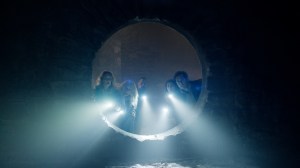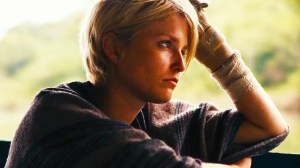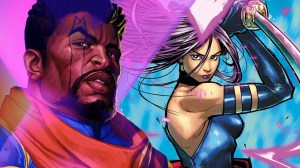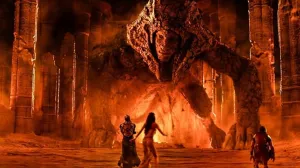Peter Jackson’s The Lord of the Rings trilogy stands as one of cinema’s most outstanding projects, earning 17 Academy Awards and universal acclaim for its faithful adaptation of J.R.R. Tolkien’s beloved novels. While many purists argue that books are always superior to their film adaptations, Jackson’s interpretation occasionally improved upon the source material. Through the power of visual storytelling, masterful performances, and Howard Shore’s iconic score, certain film moments resonated more deeply with audiences than their written counterparts, creating unforgettable scenes that have become cultural touchstones. These moments showcase how different mediums can tell the same story in unique ways. Cinema’s ability to combine visual spectacle, music, and performance sometimes leads to an emotional impact that even Tolkien’s masterful prose couldn’t match.
Videos by ComicBook.com
Here are seven moments in The Lord of the Rings films that managed to outshine their literary origins, demonstrating how adaptations can honor and enhance their source material:
Boromir’s Redemption
The films elevate Boromir’s (Sean Bean) death in The Lords of the Rings: The Fellowship of the Ring from a secondhand account into one of fantasy cinema’s most powerful moments. While the books have Aragorn (Viggo Mortensen) discovering Boromir’s body and reporting his death after the fact, the movie presents his last stand in vivid detail, allowing viewers to witness his heroic defense of Merry (Dominic Monaghan) and Pippin (Billy Boyd) against overwhelming odds. Bean’s nuanced performance, particularly in his final scene with Mortensen, transforms this moment into a moving exploration of redemption, honor, and the corrupting influence of power. By showing rather than telling this pivotal scene, the film gives Boromir’s character arc the emotional weight it deserves.
The Lighting of the Beacons
With the lightning of the beacons in The Lord of the Rings: The Return of the King, Jackson transforms a brief mention in the books into a breathtaking cinematic sequence that showcases Middle-earth’s vast scale. The film presents a visually stunning journey across snow-capped peaks as each beacon ignites, accompanied by Shore’s swelling score. This sequence serves as a powerful symbol of hope and unity and effectively communicates the desperate urgency of Gondor’s situation. The visual metaphor of light spreading across the darkness perfectly encapsulates one of Tolkien’s central themes while creating a moment of pure cinematic magic.
Sam’s Speech at Osgiliath
Though absent from the books, Sam’s (Sean Astin) rousing speech in The Lord of the Rings: The Two Towers about the enduring nature of good in the world has become one of the trilogy’s most quoted moments. Astin’s heartfelt delivery of this original monologue distills the essence of Tolkien’s motifs about hope, perseverance, and the power of ordinary people to achieve extraordinary things. The speech’s placement during the darkest moment of their journey provides a perfect counterpoint to the surrounding despair, reminding both characters and the audience of what they’re fighting for.
[RELATED: 23 Years Later, The Lord of the Rings Fans Still Have an Unanswered Question About Helm’s Deep]
The Fall of Isengard
Where Tolkien describes this event through secondhand exposition from Merry and Pippin, the film brings the Ents’ assault on Isengard to breathtaking life. The visual effects team created a memorable sequence in The Two Towers that shows nature rising against industrialization, one of Tolkien’s core themes. Watching these ancient tree shepherds tear down Saruman’s (Christopher Lee) machines and flood his stronghold provides a deep satisfaction that surpasses the book’s after-action report while maintaining the environmental message at the heart of the story.
Gandalf vs. the Balrog
A sequence in Jackson’s The Two Towers expands the confrontation between Gandalf (Ian McKellen) and the Balrog from a brief bridge encounter into an epic battle spanning multiple environments. By showing the full scope of this conflict, from the Bridge of Khazad-dûm to the mountain peak, the movie helps viewers understand the true magnitude of Gandalf’s sacrifice. The visual spectacle of these two primordial forces clashing amidst lightning and snow adds gravitas to Gandalf’s transformation into the White, making his eventual return even more meaningful than in the books.
The Ride of the Rohirrim
While Tolkien’s description of the Rohirrim’s charge in The Return of the King is undeniably powerful, the film version creates an unforgettable multi-sensory experience. Théoden’s (Bernard Hill) stirring speech delivery, combined with the thundering of hooves, the gleam of spears in the dawn light, and Shore’s rousing score, transforms this moment into cinema perfection. In addition, the sweeping camera movements that follow the cavalry charge help viewers feel like they’re part of this pivotal moment, making the triumph of good over evil viscerally satisfying.
Every Scene With Arwen
The Lord of the Rings movies greatly expanded Arwen’s (Liv Tyler) presence from a background figure mentioned primarily in the appendices to a fully realized character. Her rescue of Frodo (Elijah Wood) from the Nazgûl (replacing Glorfindel from the books) immediately establishes her as a powerful character in her own right. Plus, Tyler’s portrayal adds emotional depth to the story’s romantic elements. Her increased screen time allows for a more thorough exploration of the personal cost of immortality and the power of love to transcend racial boundaries. This expansion of Arwen’s role streamlines the narrative and provides much-needed female representation in an otherwise male-dominated story.








